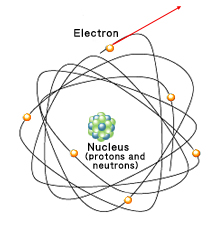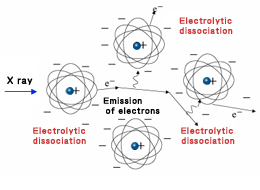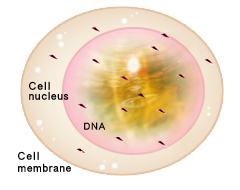How Radiation Harms Cells
What happens when cells are exposed to radiation?
In this case, an electron is emitted from the atom. Let’s take a look at the structure of an atom. In the center of the atom is a nucleus. Traveling around the nucleus are electrons. If the atom were the size of a baseball field, the nucleus would be smaller than a golf ball. Electrons can be forced from their orbit by energy from radiation. This process is called ionization or electrolytic dissociation.


Image of initial reaction to radiation
Different from electron exchange in typical chemical reactions, predicting which electrons will be emitted by exposure to radiation is impossible. Ions, also called radicals, generated in this way are extremely unstable chemically. They have very high levels of chemical reactivity, and therefore generate indiscriminate chemical reactions.

Image of minor damage to a cell
Radiation and electrons bombarded by radiation move haphazardly inside the cell, resulting in damage to the various molecules forming the cell. Chromosomal DNA inside the cell nucleus can also be damaged.
What ultimately becomes of cells harmed by radiation?
When radiation dose is large
Because of damage to DNA and resulting cell death, white blood cells can decrease and mucosa of the digestive tract may become injured, resulting in diarrhea, among other symptoms.
When radiation dose is smaller
The acute symptoms described above do not appear in exposure to lower radiation doses, but there is damage to cells, which attempt to repair themselves. Very rarely, however, mistakes do occur in the repair process, resulting in genetic abnormality (mutation). It is believed that inside such cells, certain developments may cause cancer in the future.

When part of a DNA break is repaired incorrectly, chromosome aberrations occur.
Radiation is harmful to health because radiation exposure can damage cellular DNA (mostly in the form of DNA breaks).

Recap
- ・When the human body (its cells) is exposed to radiation (X rays and gamma rays), electrons are emitted from atoms and molecules.
- ・These electrons bounce around, dispersing energy into surrounding areas.
- ・This results in the formation of radicals.
- ・These radicals react immediately with surrounding atoms, causing abnormal chemical reactions (or, minor damage to localized areas of cells).

- ・Cell membrane damage can cause cell death (apoptosis), and breaks in cellular DNA, occurring either directly or indirectly (by radicals of H2O molecules attacking DNA), can cause cell death or mutations.
- ・Mutations arise from mistakes in DNA repair.
———Several hours or several days later——— - ・Tissue recovers from injury.
———Several weeks later——— - ・Leukemia incidence increases.
———Several years later——— - ・Cancer incidence increases.
———Several decades later———

